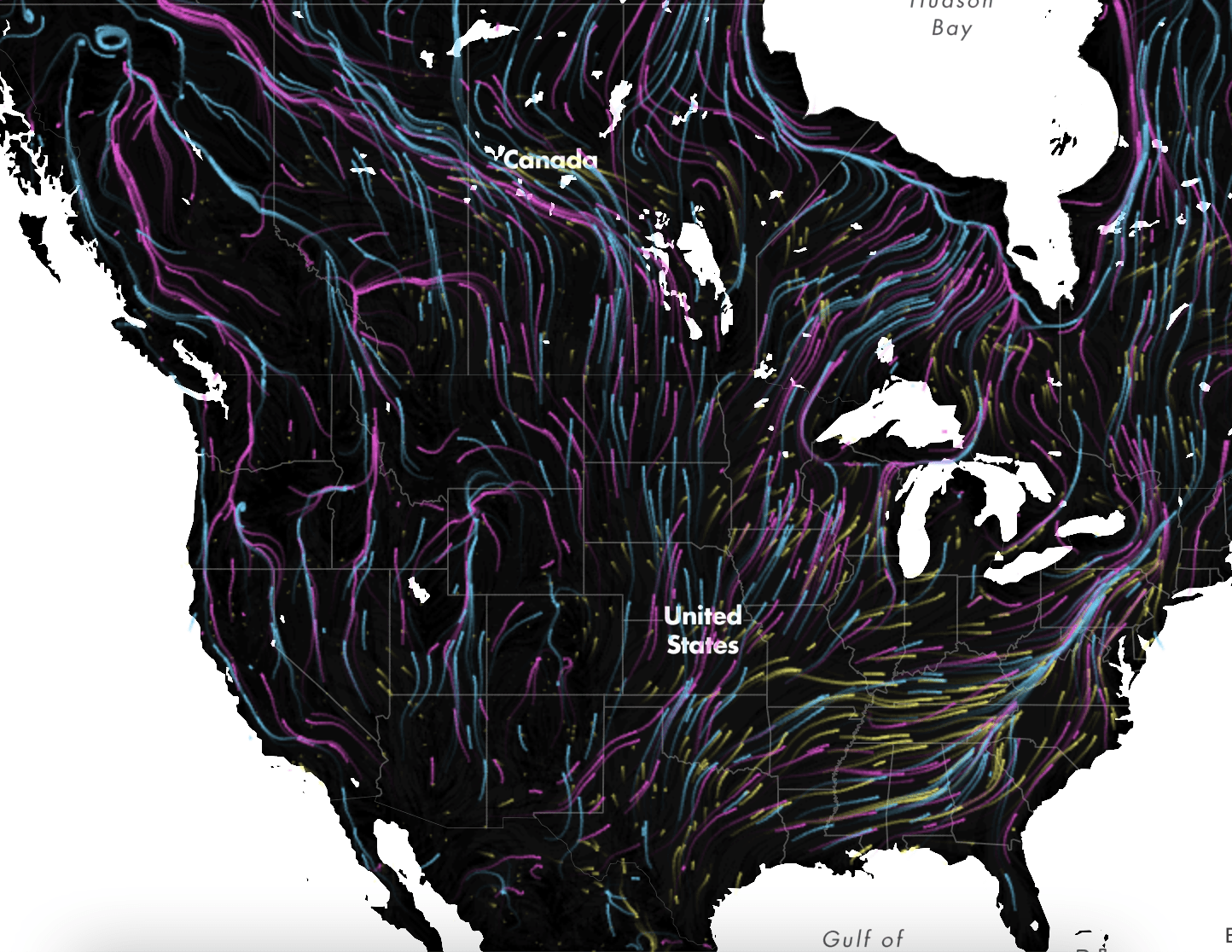Migrations in Motion
© Nature Conservancy
Reproduction (et traduction) d’extraits d’un article de Nature Conservancy.
Justine E. Hausheer est une rédactrice scientifique reconnue qui écrit pour Nature Conservancy.
Temps de lecture : 3-4 minutes
Justine écrit :
Une nouvelle étude réalisée par des chercheurs universitaires et de Nature Conservancy révèle que seulement 41 pour cent des zones naturelles aux États-Unis conservent une connectivité suffisante pour permettre aux différentes espèces de suivre les conditions climatiques qu’elles préfèrent, à mesure que le climat mondial change. Les scientifiques ont modélisé la répartition et les besoins d’habitat de 2 903 espèces de vertébrés dans l’hémisphère occidental en fonction de l’utilisation des terres et des régimes climatiques prévus.
Dan Majka, cartographe et analyste pour Nature Conservancy, a donné vie à ces données en créant une série de cartes qui montrent les corridors que les mammifères, amphibiens et autres animaux emprunteront pour se déplacer vers de nouveaux habitats avec les changements climatiques prévus. Les cartes dynamiques de Dan, inspirées par les cartes des vents des États-Unis et utilisant les codes des cartes mondiales des vents, adaptés par Chris Helm, permettent aux scientifiques et au public de constater les impacts des changements climatiques sur les animaux du continent et de visualiser les couloirs dont ils auront besoin pour se déplacer.
La question est la suivante : quand les animaux se déplaceront pour trouver un nouvel habitat parce que leur ancien milieu de vie se modifie en raison des changements climatiques, où iront-ils et comment les humains interagiront-ils avec eux? En regardant la carte pour le sud du Québec, la région la plus populeuse de la province, on constate la densité de la migration des animaux dans le secteur.
Comment peut-on aider?
La COP15, la conférence de l’ONU sur la biodiversité qui a eu lieu à Montréal en décembre, s’est conclue par un accord historique pour protéger 30 % des eaux intérieures, des terres et des zones côtières d’ici 2030.
C’est un objectif TRÈS ambitieux qui peut susciter de l’écoanxiété chez certaines personnes.
Et si on le décortiquait pour regarder de plus près ce que chaque collectivité peut faire de son côté?
La Fiducie de conservation Massawippi (FCM) travaille sur des projets de conservation depuis 2011. Avec le Corridor appalachien (créé en 2002) et 16 autres groupes de conservation, nous sensibilisons le public, accueillons des projets de recherche et protégeons les terres grâce à des dons, des achats et des servitudes. Nous préparons également des programmes éducatifs pour former une communauté de futurs protecteurs et protectrices de l’environnement.
La majorité des terres que nous avons protégées jusqu’à présent sont reliées entre elles, créant ainsi un « corridor » pour la faune et la flore. Nous cherchons à créer davantage de connectivité avec nos projets d’expansion. Nous avons commencé dans une zone identifiée par le Corridor appalachien comme étant la plus vulnérable au développement par l’humain. Ces terres, d’une immense valeur écologique, nécessitaient une attention immédiate au risque d’être perdues.
Qui les a protégées? Un groupe de personnes sensibilisées qui n’étaient ni scientifiques ni environnementalistes, mais qui savaient au fond d’elles-mêmes que la vallée Massawippi était un endroit spécial, tant sur le plan environnemental, esthétique ou historique, qu’il fallait protéger pour le bien de tous.
Bien que les administrateurs et administratrices de la FCM et les membres du conseil d’administration de la Fondation Massawippi (FMF) aient changé au fil du temps, les membres actuels sont toujours des bénévoles passionnés qui apportent leurs compétences variées. Nous avons appris à identifier et à reconnaître les zones problématiques. Nous travaillons avec nos différents partenaires, des municipalités et d’autres ONG pour voir comment nous pourrions protéger plus de terres ou changer la façon dont nous en prenons soin.
Les avantages de la conservation des terres privées combinés avec les projets de conservation provinciaux et nationaux aident à atténuer les effets des changements climatiques. Les particuliers ont un rôle important à jouer dans la régulation de la qualité de l’eau et la protection de zones naturelles et d’écosystèmes irremplaçables. L’atteinte des objectifs dans la portion sud du Québec dépend de la contribution de particuliers et de fiducies foncières locales. Après tout, la majeure partie du territoire appartient à des propriétaires privés.
Quelques statistiques sur l’utilisation des terres du bassin versant du lac Massawippi
512 km2 au Canada (un autre 90 km2 au Vermont)
8,17 km2, la superficie du lac Massawippi
239,6 km2 de terres boisées
187,8 km2 de terres agricoles
4,86 km2 de terres protégées par la Fiducie de conservation Massawippi
Nous avons encore du chemin à faire, mais nous faisons des progrès. Certaines zones conservées permettent l’accès aux forêts et aux terres pour des activités récréatives et éducatives, contribuant ainsi à la santé et au bien-être des individus et à la protection des terres écologiquement fragiles, qui abritent insectes, oiseaux et autres espèces de la faune et de la flore. D’autres zones sont laissées intactes pour l’usage exclusif de la faune.
Le changement climatique est mondial et les mesures efficaces, elles, sont locales.
Engagement mondial 30/30 de la COP15, engagement 30/30 pour la FCM et la FMF dans la vallée Massawippi


